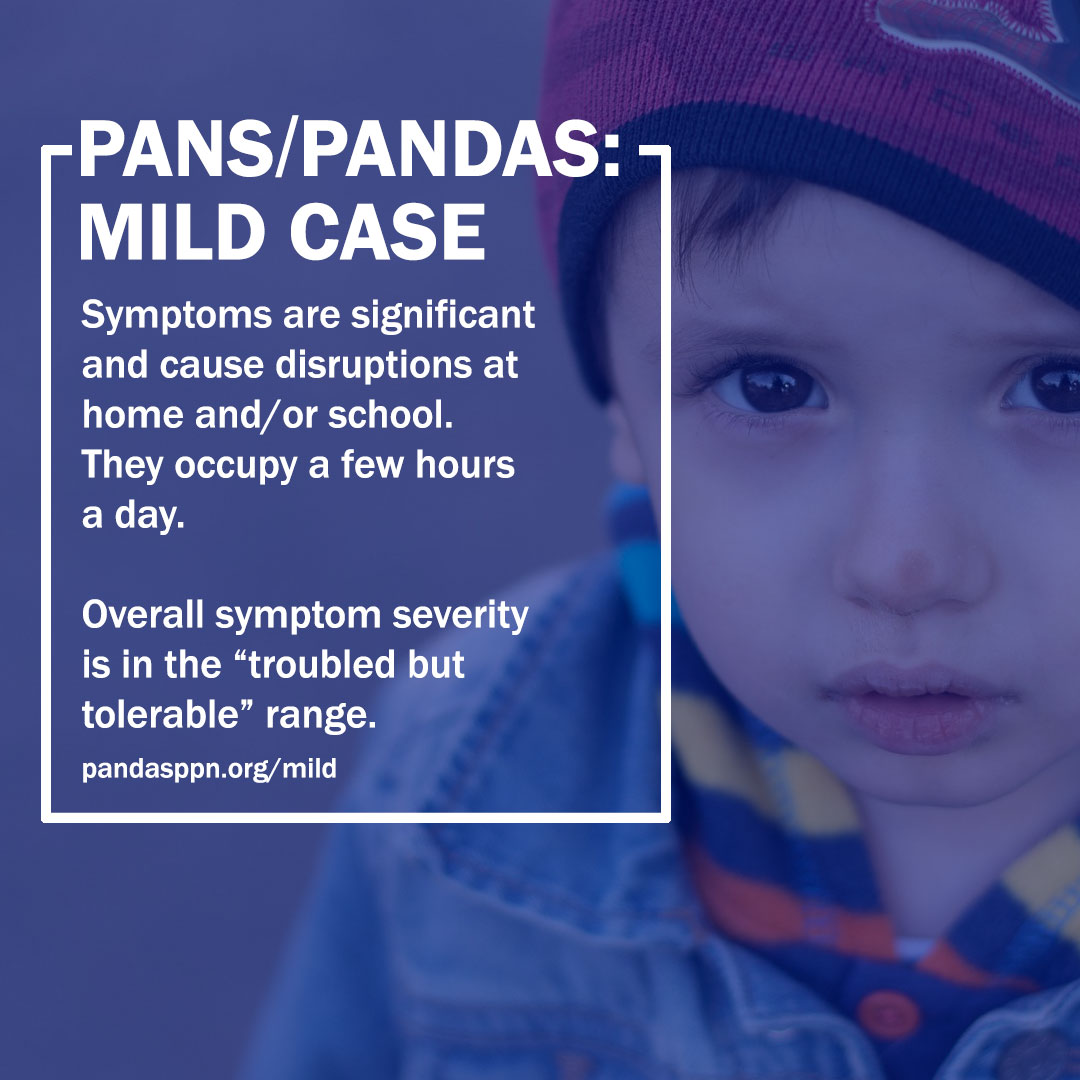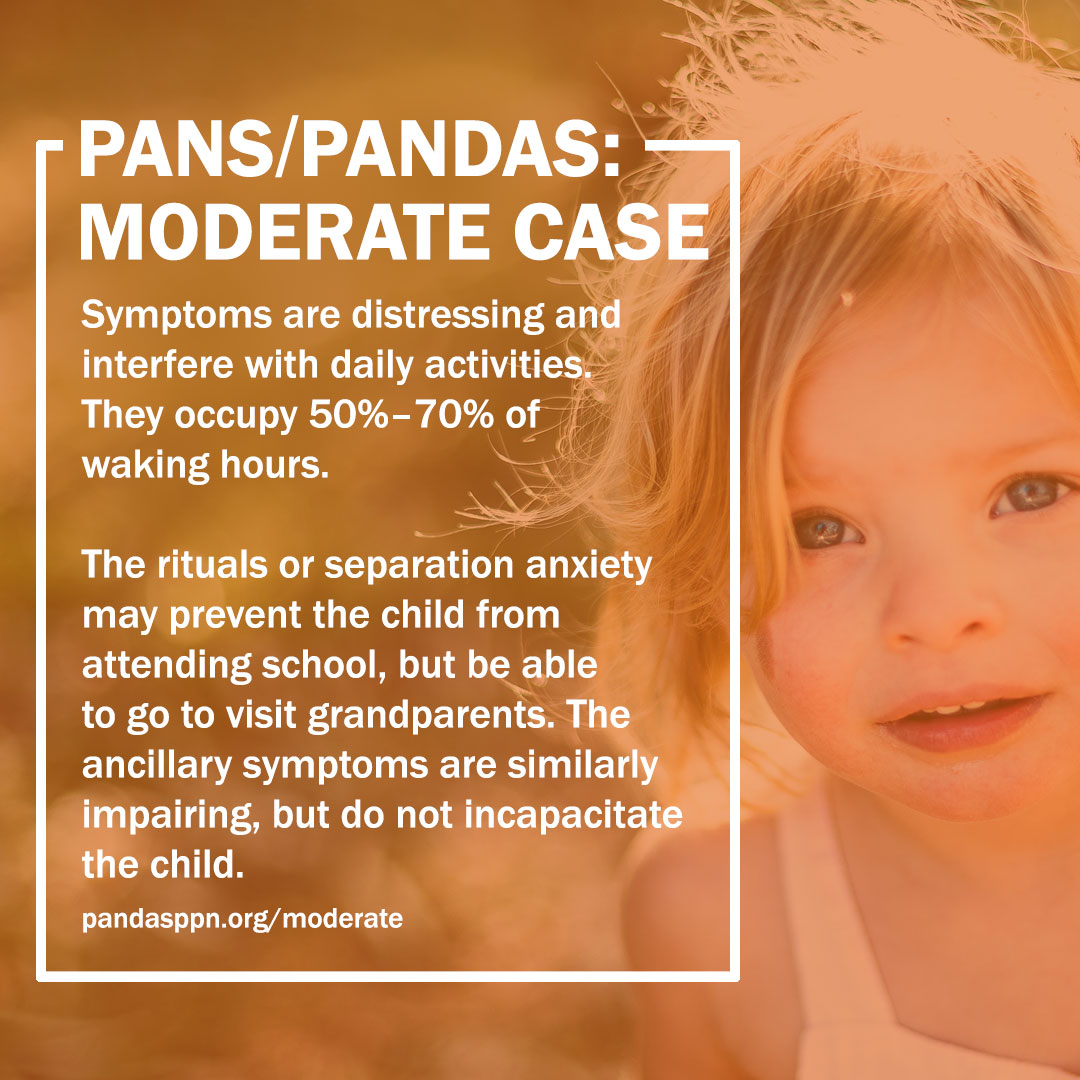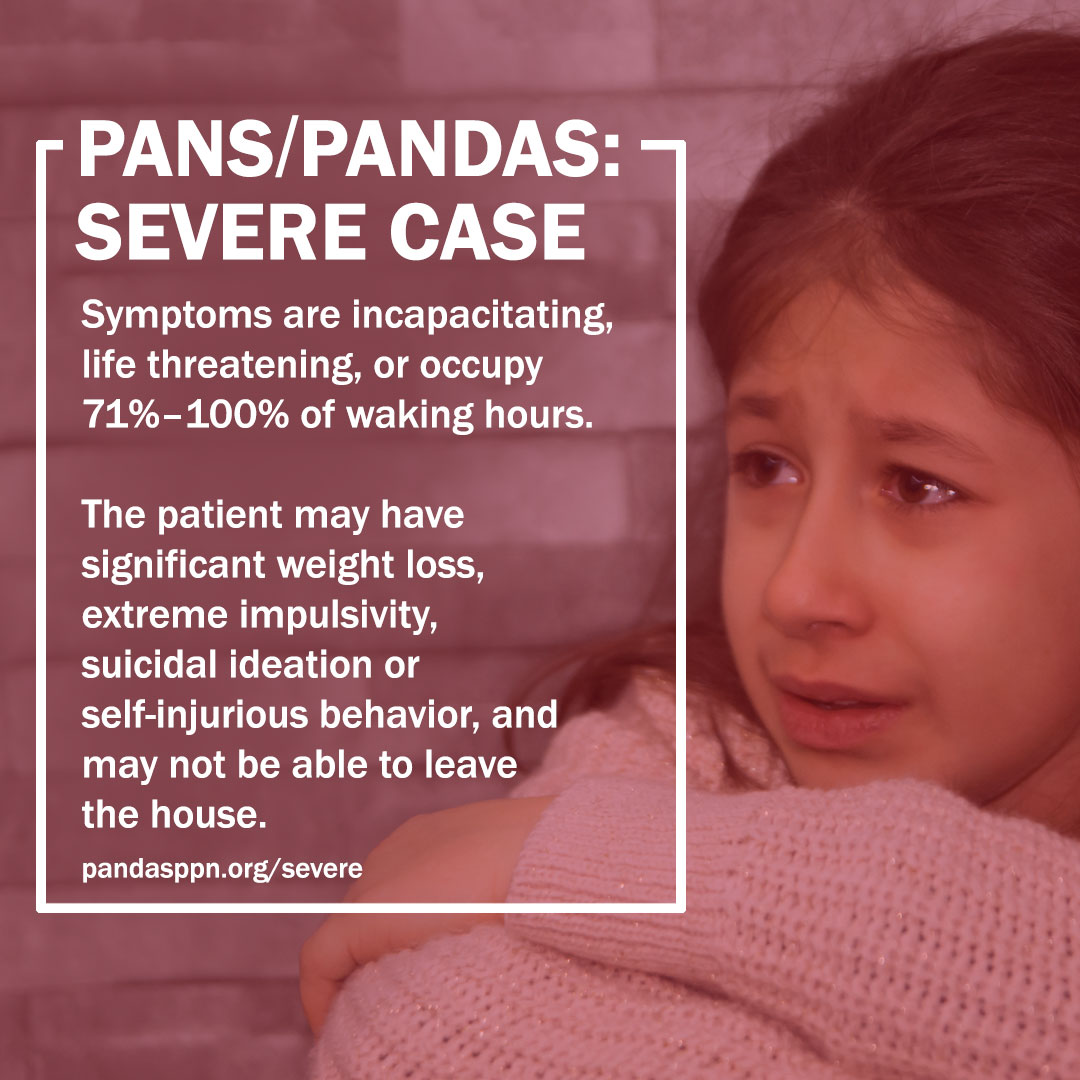SYMPTOM SEVERITY BASED TREATMENT
PANS PANDAS: MILD CASE
Children with mild symptoms have obvious impairments as a result of their PANS/PANDAS symptomatology, but these are limited to certain situations or settings. For example, the child might need a parent to stay while falling asleep, but able to attend school or go to a friend’s house (perhaps with frequent phone calls for reassurance). The symptoms may occupy a few hours a day and may cause minor disruptions at home and in school, but these are manageable with reasonable accommodations. Overall symptom severity is in the “troubled but tolerable” range.
Treatment of mild illness may include: antibiotics, corticosteroids, anti-inflammatories, and CBT/ERP.
An initial 2 week course of treatment dose of antibiotics should be prescribed while waiting for lab results. If the patient has 2+ recurrences, prophylactic antibiotics may be considered.
Anti-inflammatories may be beneficial. Oral nonsteroidal anti-inflammatory drugs (NSAIDs) such as ibuprofen or naproxen may be considered. A 5 day oral corticosteroid bursts may hasten recovery and minimize residual symptoms.
IVIG and plasmapheresis are not deemed appropriate treatments for children with mild symptoms. Both IVIG and plasmapheresis are “invasive” procedures which carry a number of associated risks. (Please see PPN Treatment Options: IVIG).
Visit the PANS/PANDAS Treatment Guidelines for Mild Cases for a more detailed review.
PANS PANDAS: MODERATE CASE
Children with moderate symptoms of PANS/PANDAS have symptoms that are distressing and interfere with daily activities. They occupy 50%–70% of waking hours. The rituals or separation anxiety may prevent the child from attending school, but would be able to go to visit grandparents (if parent is along) or have friends come over for brief periods. The ancillary symptoms are similarly impairing, but do not incapacitate the child.
Clinicians should consider an initial 3-4 week course of antibiotics. Depending on the course of the illness, a treatment dose of antibiotics may be extended to 6 weeks.
Corticosteroids and NSAIDs may be beneficial, especially when implemented in the earlier stages of symptom onset. A positive response to steroids is a good indication that IVIG therapy will be helpful; however, a tepid response is not a predictor of IVIG failure. Depending on the course of the illness, moderate cases may benefit from 30 days of steroids with taper.
Immunomodulatory therapy is justified in moderate cases to relieve suffering and hasten recovery. Intravenous immunoglobulin (IVIG) is likely to be the preferred therapy for moderate cases.
Prophylactic antibiotics are often useful in the management of PANS/PANDAS, as they help to prevent strep-triggered exacerbations.
Cognitive behavior therapy should be started as soon as the child can tolerate it. In the interim, the child and parent should receive supportive therapy, including education about the “dos and don’ts” of managing OCD and separation anxiety. For example, as described above, parents will want to resist accommodating their child’s OCD, as their efforts may provide short-term anxiety relief, but it comes at the expense of longer-term increase in symptoms (due to the “rational irrationality” of OCD).
Psychotropic medications, including SSRIs, could also be considered, but MUST be started at an extremely low dose with a very slow upward taper to avoid activation, agitation, akathisia, and other adverse effects of the drugs.
Visit the PANS/PANDAS Treatment Guidelines for Moderate Cases for a more detailed review.
PANS PANDAS: SEVERE CASE
Severe cases are defined as those in which the symptoms are incapacitating, life threatening, or occupy 71%–100% of waking hours. For example, children with significant weight loss (>10-15% of body mass) due to anorexia or obsessional food/eating restrictions related to fear of contamination, fear of choking or vomiting and others; children with extreme impulsivity (and behavioral regression), such as the child who attempts to jump off a roof because they think they can fly; or children with suicidal ideation or self-injurious behavior, e.g., trying to jump from a moving car or threatening self or others with knives or fire. In these cases, the child’s health and well-being is threatened by the PANS/PANDAS symptoms and aggressive treatment is warranted.
Children with severe symptoms of PANS/PANDAS are suffering from extreme anxiety (separation or generalized) and obsessional fears. The OCD symptoms prevent the child from attending school, playing with friends/alone, and accomplishing tasks, such as showering or toileting. Because of the separation anxiety, the child is reluctant to leave the house and sticks closely to parents – following them into the bathroom and insisting on sleeping in the parents’ bed (or having the parent sleep in his). In addition to the OCD and anxiety symptoms, the child may have extreme irritability, increased aggression and emotional lability, and a dramatic personality change.
The treatment options listed for moderate illness may be considered for patients experiencing a severe/extreme form of PANDAS/PANS. Treatment for severe/extreme cases may be addressed more aggressively due to severity of symptoms. In addition, plasmapheresis might be the first-line treatment for severe illness because it has been shown to produce the greatest degree of symptom improvement over the shortest period of time.
If plasmapheresis is not available, then IVIG would be a reasonable alternative. Should obtaining plasmapheresis or IVIG take time, the physician could start the patient immediately on a therapeutic dose of antibiotics. In addition to the immunomodulatory therapies, supportive therapy would include re-feeding protocols for the children with anorexia; cognitive behavioral therapy for obsessional food/eating restrictions and the self-injurious behaviors; and educational/supportive therapy for parents (and later for the child) to ensure that symptoms do not escalate further. [Obsessive-compulsive symptoms of PANS/PANDAS behave similarly to those of “garden variety” OCD and will increase in severity if accommodated by caregivers. For example, a child who fears that foods are contaminated may find it increasingly difficult to eat anything even if a parent has gone to great lengths to present him with only sterilized or “safe” foods, as the parents’ actions reinforce the (irrational!) obsessional fear; i.e., the child begins to believe that the obsessional fear is rational because his parents are acting as if it is.]
Psychotropic medications may be useful, but should be selected carefully, as drugs which activate the central nervous system (some of the SSRIs) often produce more side effects. All drugs must be started at a very low dose and tapered upwards gradually in order to increase tolerability.
Visit the PANS/PANDAS Treatment Guidelines for Severe Cases for a more detailed review.
CHRONIC-STATIC COURSE AND REFRACTORY DISEASE COURSE
Most patients with PANS/PANDAS remit with appropriate treatment. For a few children, the clinical course may evolve to become a chronic autoimmune condition. For such cases, more aggressive treatment may be warranted.
For patients who no longer respond to the PANS/PANDAS treatments, the focus may need to shift to a rehabilitation mode.
LONG TERM PROGNOSIS: HOW LONG DOES PANS/PANDAS LAST?
To date, there have been no long-term studies of PANS/PANDAS patients. However, clinicians who treated PANS/PANDAS patients when they were children and are now young adults report that their treated patients are highly functioning and, in many cases, without any or significant OCD, tics, or comorbid symptoms.
Many of the original patients of NIH are now healthy adults. Others have also remained symptom-free, although when infected with a pathogen, especially Group A strep, must use antibiotics to control the flare-up periods.








